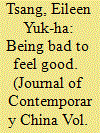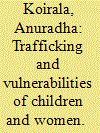|
|
|
Sort Order |
|
|
|
Items / Page
|
|
|
|
|
|
|
| Srl | Item |
| 1 |
ID:
171038


|
|
|
|
|
| Summary/Abstract |
The plight of male migrant workers in China warrants critical attention because their diminished opportunity for life success has created a public health issue. To cope with hopelessness and despair they engage in risky behaviors involving paid sex and drugs. This article extends Connell ’s notion of hegemonic masculinity, linking urban migration with a rampant ‘masculinity crisis’ engulfing these single migrant men. Interviews with 100 male migrants who admitted to regularly buying commercial sex in low-end and mid-tier bars revealed underlying cultural tensions which drive them to use paid sex and drugs to help them cope with their emasculated reality. This article facilitates understanding of China’s masculinity crisis against the backdrop of the nation’s post-socialist transition in a wider social, cultural, and historical structure.
|
|
|
|
|
|
|
|
|
|
|
|
|
|
|
|
| 2 |
ID:
069226


|
|
|
| 3 |
ID:
171039


|
|
|
|
|
| Summary/Abstract |
In recent years, exposés on the trafficking of women have caught the public’s attention in China. However, due to data scarcity, the scope and nature of such criminal activity are not well understood. The authors of this study provide a new angle in the analysis of human trafficking by digitizing and analyzing court sentencing documents on trafficking in China during 2014–2015.
Through mapping court data to geographic information and performing network analysis, the study presented a comprehensive picture of intra-provincial, inter-provincial, and international trafficking patterns. The data showed that international trafficking has become the largest category in the trafficking of women, and victims were typically young women in their 20s originating from Vietnam, Myanmar, and North Korea who were sold into central provinces. Domestically, inter-provincial trafficking outnumbers intra-provincial cases. Across provincial borders, women were trafficked from southwest to central provinces. Intra-provincial trafficking was concentrated in four provinces: Henan, Anhui, Shandong, and Hebei.
|
|
|
|
|
|
|
|
|
|
|
|
|
|
|
|
| 4 |
ID:
140060


|
|
|
| 5 |
ID:
121931


|
|
|
|
|
| Publication |
2013.
|
| Summary/Abstract |
Trafficking in women is a momentous disobedience of Human Rights and one of the most solemn organized crimes of the day, transcending cultures, geography and time. The response by the agencies concerned in addressing the issues has been far from satisfactory, which has exacerbated the violations and harm to the trafficked persons.
|
|
|
|
|
|
|
|
|
|
|
|
|
|
|
|
| 6 |
ID:
099868


|
|
|
|
|
| Publication |
2010.
|
| Summary/Abstract |
In the context of human trafficking, women are frequently portrayed as victims, whereas men are usually seen as offenders. In this article, we will demonstrate that women can also fulfil active, even leading, roles in human trafficking networks. Based on data collected from 89 court files in various Dutch courts in 2006-2007, we have analysed the role, tasks, and activities of these women. Assessing their independence, their tasks, and the extent of their equality in relationships with male traffickers, we have divided them into three categories: supporters, partners-in-crime, and madams. We have found that there is a wide variety of possible roles within the framework of human trafficking activities, and that African madams hold key positions in international human trafficking networks.
|
|
|
|
|
|
|
|
|
|
|
|
|
|
|
|
|
|
|
|
|